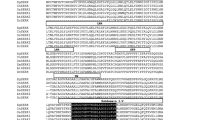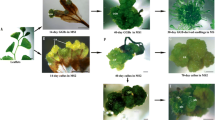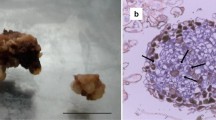Abstract
Somatic embryogenesis receptor kinase (SERK) gene is known to be a marker of somatic embryogenesis in several plant species. The present study reported the isolation and characterization of a SERK gene ortholog, designated as McSERK, in Momordica charantia, an important medicinal plant. The complete coding region of McSERK was found to encode a 627 amino acid protein which contained an N-terminal signal peptide, a leucine zipper, five leucine rich repeats, a serine-proline-proline domain, a transmembrane domain, a kinase domain and the C-terminal region, depicting the typical characteristic features of SERK-family proteins. Phylogenetic analysis suggested that McSERK was highly similar to the SERK proteins of Cucumis sativus, Glycine max and Medicago truncatula. Homology modeling was attempted to construct the three dimensional structure of McSERK protein which showed that it corresponded to a monomeric protein. McSERK expression was high in embryogenic callus but its expression was relatively low in different plant organs. The high expression of McSERK transcript in the embryogenic callus confirmed its association with somatic embryogenesis in M. charantia.






Similar content being viewed by others
References
Agarwal M, Kamal R (2004) In vitro clonal propagation of Momordica charantia L. Indian J Biotechnol 3(3):426–430
Ahmed I, Lakhani MS, Gillett M, John A, Raza H (2001) Hypotriglyceridemic and hypocholesterolemic effects of anti-diabetic Momordica charantia (karela) fruit extract in streptozotocin induced diabetic rats. Diabetes Res Clin Pract 51:155–161
Albertini E, Marconi G, Reale L, Barcaccia G, Porceddu A, Ferranti F, Falcinelli M (2005) SERK and APOSTART: candidate genes for apomixis in Poa pratensis. Plant Physiol 138:2185–2199
Albrecht C, Russinova E, Hecht V, Baaijens E, Vries SD (2005) The Arabidopsis thaliana somatic embryogenesis receptor-like kinases1 and 2 control male sporogenesis. Plant Cell 17:3337–3349
Albrecht C, Russinova E, Kemmerling B, Kwaaitaal M, de Vries S (2008) Arabidopsis somatic embryogenesis receptor kinase proteins serve brassinosteroid-dependent and -independent signaling pathways. Plant Physiol 148:611–619
Baudino S, Hansen S, Brettshneider R, Hecht VFG, Dresselhaus T, Lors H, Dumas C, Rogowsky PM (2001) Molecular characterization of two novel maize LRR receptor-like kinase, which belong to the SERK gene family. Planta 213:1–10
Chugh A, Khurana P (2002) Gene expression during somatic embryogenesis: recent advances. Curr Sci 83(6):715–730
Chung HH, Chen JT, Chang WC (2007) Plant regeneration through direct somatic embryogenesis from leaf explants of Dendrobium. Biol Plant 51:346–350
Colcombet J, Boisson-Dernier A, Ros-Palau R, Vera CE, Schroeder JI (2005) Arabidopsis somatic embryogenesis receptor kinase 1 and 2 are essential for tapetum development and microspore maturation. Plant Cell 17:3350–3361
Cueva A, Concia L, Cella R (2012) Molecular characterization of a Cyrtochilum loxense somatic embryogenesis receptor-like kinase (SERK) gene expressed during somatic embryogenesis. Plant Cell Rep 31:1129–1139
Dos Santos KGB, Mariath JEA, Moco MCC, Bodanese-Zanettini MH (2006) Somatic embryogenesis from immature cotyledons of soybean (Glycine max (L.) Merr.): ontogeny of somatic embryos. Braz Arch Biol Technol 49(1):49–55
Edwards K, Johnstone C, Thompson C (1991) A simple and rapid method for the preparation of plant genomic DNA for PCR analysis. Nucleic Acids Res 19(6):1349
Elmaghrabi AM, Ochatt S, Rogers HJ, Francis D (2013) Enhanced tolerance to salinity following cellular acclimation to increasing NaCl levels in Medicago truncatula. Plant Cell Tiss Organ Cult 114:61–70
Elviana M, Rohani ER, Ismanizan I, Normah MN (2011) Morphological and histological changes during the somatic embryogenesis of mangosteen. Biol Plant 55:731–736
Hecht V, Vielle-Calzada JP, Hartog MV, Schmidt ED, Boutilier K, Grossniklaus U, de Vries SC (2001) The Arabidopsis somatic embryogenesis receptor kinase1 gene is expressed in developing ovules and embryos and enhances embryogenic competence in culture. Plant Physiol 127:803–816
Hu H, Xiong L, Yang Y (2005) Rice SERK1 gene positively regulates somatic embryogenesis of cultured cell and host defense response against fungal infection. Planta 222:107–117
Huang X, Lu XY, Zhao JT, Chen JK, Dai XM, Xiao W, Chen YP, Chen YF, Huang XL (2009) MaSERK1 gene expression associated with somatic embryogenic competence and disease resistance response in banana (Musa spp.). Plant Mol Biol Rep 28:309–316
Huang X, Lu XY, Zhao JT, Chen JK, Dai XM, Xiao W, Chen YP, Chen YF, Huang XL (2010) MaSERK1 gene expression associated with somatic embryogenic competence and disease resistance response in banana (Musa spp.). Plant Mol Biol Rep 28:309–316
Kwaaitaal MACJ, de Vries S (2007) The SERK1 gene is expressed in procambium and immature vascular cells. J Exp Bot 58(11):2887–2896
Kyte J, Doolittle R (1982) A simple method for displaying the hydropathic character of a protein. J Mol Biol 157:105–132
Lewis MW, Leslie ME, Fulcher EH, Darnielle L, Healy P, Youn JY, Liljegren SJ (2010) The SERK1 receptor-like kinase regulates organ separation in Arabidopsis flower. Plant J 62(5):817–828
Livak KJ, Schmittgen TD (2001) Analysis of relative gene expression data using real-time quantitative PCR and the 2−ΔΔCT method. Methods 25(4):402–408
Ma J, He Y, Wu C, Liu H, Hu Z, Sun G (2012) Cloning and molecular characterization of a SERK gene transcriptionally induced during somatic embryogenesis in Ananas comosus cv. Shenwan. Plant Mol Biol Rep 30:195–203
Maillot P, Lebel S, Schellenbaum P, Jacques A, Walter B (2009) Differential regulation of SERK, LEC-like and pathogenesis related genes during indirect secondary somatic embryogenesis in grapevine. Plant Physiol Biochem 47:743–752
Miura T, Itoh C, Iwamoto N, Kato M, Kawai M, Park SR, Suzuki I (2001) Hypoglycemic activity of the fruit of the Momordica charantia in type 2 diabetic mice. J Nutr Sci Vitaminol 47:340–344
Murashige T, Skoog F (1962) A revised medium for rapid growth and bioassays with tobacco tissue cultures. Physiol Plant 15:473–497
Nolan KE, Irwanto RR, Rose RJ (2003) Auxin up-regulates MtSERK1 expression in both Medicago truncatula root-forming and embryogenic cultures. Plant Physiol 33:218–230
Nolan KE, Kurdyukov S, Rose RJ (2009) Expression of the somatic embryogenesis receptor-like kinase1 (SERK1) gene is associated with developmental change in the life cycle of the model legume Medicago truncatula. J Exp Bot 60(6):1759–1771
Paul A, Mitter K, Raychaudhuri SS (2009) Effect of polyamines on in vitro somatic embryogenesis in Momordica charantia L. Plant Cell Tiss Organ Cult 97:303–311
Pérez-Núñez MT, Souza R, Sáenz L, Chan JL, Zúñiga-Aguilar JJ, Oropeza C (2009) Detection of a SERK-like gene in coconut and analysis of its expression during the formation of embryogenic callus and somatic embryos. Plant Cell Rep 28:11–19
Petersen TN, Brunak S, von Heijne G, Nielsen H (2011) SignalP 4.0: discriminating signal peptides from transmembrane regions. Nat Methods 8:785–786
Rohani ER, Ismanizan I, Noor NM (2012) Somatic embryogenesis of mangosteen. Plant Cell Tiss Organ Cult 110:251–259
Salaj J, von Recklinghausen IR, Hecht V, de Vries SC, Schel JHN, van Lammeren AAM (2008) AtSERK1 expression precedes and coincides with early somatic embryogenesis in Arabidopsis thaliana. Plant Physiol Biochem 46:709–714
Santa-Catarina C, Hanai LR, Dornelas MC, Viana AM, Floh EIS (2004) SERK gene homology expression, polyamines and amino acids associated with somatic embryogenic competence of Ocotea catharinensis Mez. (Lauraceae). Plant Cell Tiss Organ Cult 79:53–61
Santos MO, Aragão FJ (2009) Role of SERK genes in plant environmental response. Plant Signal Behav 4(12):1111–1113
Schmidt ED, Guzzo F, Toonen MA, de Vries SC (1997) A leucine rich repeat containing receptor-like kinase marks somatic plant cells competent to form embryos. Development 124:2049–2062
Shimada T, HirabayashI T, Endo T, Fujii H, Kita M, Omura M (2005) Isolation and characterization of the somatic embryogenesis receptor-like kinase gene homologue (CitSERK1) from Citrus unshiu Marc. Sci Hortic 103:233–238
Singla B, Khurana JP, Khurana P (2008) Characterization of three somatic embryogenesis receptor kinase genes from wheat, Triticum aestivum. Plant Cell Rep 27:833–843
Somleva MN, Schmidt EDL, de Vries SC (2000) Embryogenic cells in Dactylis glomerata L. (Poaceae) explants identified by cell tracking and by SERK expression. Plant Cell Rep 19:718–726
Song D, Li G, Song F, Zheng Z (2008) Molecular characterization and expression analysis of OsBISERK1, a gene encoding a leucine-rich repeat receptor-like kinase, during disease resistance responses in rice. Mol Biol Rep 35:275–283
Sultana RS, Bari Miah MA (2003) In vitro propagation of Karalla (Momordica charantia Linn.) from nodal segment and shoot tip. J Biol Sci 3:1134–1139
Thomas C, Meyer D, Himber C, Steinmetz A (2004) Spatial expression of a sunflower SERK gene during induction of somatic embryogenesis and shoot organogenesis. Plant Physiol Biochem 42:35–42
Tichtinsky G, Vanoosthuyse V, Cock JM, Gaude T (2003) Making inroads plant receptor kinase signalling pathways. Trends Plant Sci 8:231–237
Zhang S, Liu X, Lin Y, Xie G, Fu F, Liu H, Wang J, Gao S, Lan H, Rong T (2011) Characterization of a ZmSERK gene and its relationship to somatic embryogenesis in a maize culture. Plant Cell Tiss Organ Cult 105:29–37
Acknowledgments
The authors sincerely acknowledge the financial assistance provided by Council of Scientific and Industrial Research [CSIR No. 38/(1261)/EMR II, dt. 17.05.10].
Author information
Authors and Affiliations
Corresponding author
Rights and permissions
About this article
Cite this article
Talapatra, S., Ghoshal, N. & Raychaudhuri, S.S. Molecular characterization, modeling and expression analysis of a somatic embryogenesis receptor kinase (SERK) gene in Momordica charantia L. during somatic embryogenesis. Plant Cell Tiss Organ Cult 116, 271–283 (2014). https://doi.org/10.1007/s11240-013-0401-4
Received:
Accepted:
Published:
Issue Date:
DOI: https://doi.org/10.1007/s11240-013-0401-4




